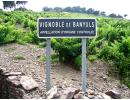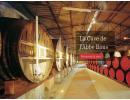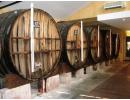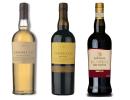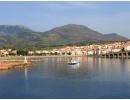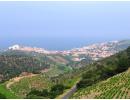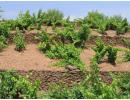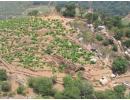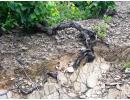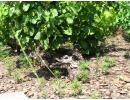Cornet et Cie
Cornet & Cie 2011 - Banyuls Blanc
The wine is a blend of 70% Grenache Gris and 30% Grenache Blanc, the vines average 45 years of age producing a low yield of 25 hl/ha. The grapes are hand-picked and destemmed at the cellar after sorting. A pre-fermentation skin-maceration is done for the Grenache Blanc lasting 4 hours. After the press, the juice is fermented in stainless steel vats, the mutage will be done on the juice to stop the fermentations, leaving a residual sugar averaging 85 g/l and an alcohol content of 16.5% Vol. This process is known as “mutage sur moût” which is common for fortifying white VDN. The wine is then aged in stainless steel vats for about 7 months.
PVins notes: The finished wine shows white flowers aromas on the nose combined with pears and white peaches with a hint of eau de vie. The sweetness, alcohol and acidity are all well-balanced. An open bottle may be kept for up to 2 weeks. The cellaring potential is about 10 years depending on how you like to drink your Banyuls. Recommended temperature for service is 8°c to 12°c.
Terres des Templiers “Rimage Mise Tardive” 2015 - Banyuls
This is a young style of Vin Doux Naturel (VDN) from Banyuls. Made from old Grenache Noir vines averaging a low yield of 30 hl/ha. The hand-picked grapes are destemmed and the grains put into closed oak vats for the fermentations. After about 3 to 4 days of fermentations a natural alcohol level of 8%-9% is reached. The must is now fortified with grape spirit (96% pure) which cannot exceed 10% of the must’s volume, the procedure is called “mutage sur grain”. The must and spirit are left to macerate for 3 weeks, the must is then pressed and the wine is transfered to oak barrels for ageing that will last 12 months with the barrels topped up. The finished wine will have a residual sugar averaging 115g/l and an alcohol content of 15% Vol.
PVins notes: A fortified red wine with fruity and spicy flavours and aromas, the smooth grain tannins will give it the structure of a classic Grenache wine. The sweetness, alcohol and acidity are all well-balanced on the long finish. An open bottle may be kept for up to 2 weeks, preferably in a cool environment. The cellaring potential is a couple of decades depending on how you like to drink your Banyuls. A great wine for dark chocolate desserts, to be consumed at 14°c - 16°c.
Another wine produced by Cave de L'Abbé Rous is the Castell des Hospices Banyuls Grand Cru.
Cornet & Cie is bottled by the Cave de l’Abbé Rous since 1997, which is affiliated to the famous Terres des Templiers cooperative. The wine used to be labeled as Domaine Mas Cornet until the mid-2000s. The estate was selected by the Cave de L’abbé Rous with some other growers in the Collioure and Banyuls appellations for their high quality vineyards, enabling them to produce high quality Banyuls, Banyuls Grand Cru and "cuvée spéciale". The cellar was named as an homage to the village priest Abbé Rous. He was the first person in 1871 to age and sell bottled Banyuls wines. His motivation behind the project was to finance the construction of a church as the newly appointed priest of Banyuls sur Mer.
The Banyuls wines produced by Cave de L’abbé Rous are considered to be amongst the best of the appellation. They can be found on the wine lists of numerous Michelin Star restaurants throughout France including up market delicatessen and cellars.
The cooperative Terres des Templiers changed its name in 2013 from Cellier des Templiers in homage to the Knights Templars. They helped develop the quality vineyards of Banyuls that we know today during the 12th and 13th centuries at the time of the crusades. Terres des Templiers produces 75% of the wines from banyuls and Collioure representing 1000 ha. Cellier des Templiers was originally created in 1950 following the fusion of 8 cellars.
The heart of Cornet & Cie has its Grenache Noir vines planted inland between 100-600 metres above sea level facing south and south-east. Here the grapes ripen earlier than average due to its microclimate. The vines average 45 years of age and are planted on slopes composed of Cambrian schist.
The winemaking process in producing fortified red Banyuls starts with the hand-picking of the Grenache grapes that have reached a high maturity with a sugar concentration equivalent to 252 grams of sugar per litre. At the cellar the grapes are destemmed and the grains put into closed oak vats for the fermentations to take place. After 3 to 4 days of fermentations a natural alcohol level of 8%-9% is reached. The must is now fortified with grape spirit (96% pure) which cannot exceed 10% of the must’s volume, the procedure is called “mutage sur grain”. This will stop the fermentation to keep some residual sugar as a Vin Doux Naturel (VDN). The must and spirit are left to macerate for 3 weeks. After the macerations the must will be pressed and the wine transfered to barrels for ageing. The "Rimage Mise Tardive" is aged for 12 months in oak barrels that are topped up to prevent any oxidation. The finished wines must have a minimum of 15% alcohol as per the appellation regulation.
Regarding the white Banyuls, the Grenache Gris and Grenache Blanc grapes will be hand-picked under the same conditions as the reds above. A pre-fermentation skin-maceration is done for the Grenache Blanc lasting 4 hours. After the pressing the juice is fermented in stainless steel vats. The mutage will be done in this case on the juice to stop the fermentations leaving some residual sugar. This process Is known as “mutage sur moût” which is common for fortifying white VDN. The wine is then aged in stainless steel vats for about 7 months.
Links: AOP Banyuls - Roussillon map
BANYULS
The Banyuls appellation created in 1936 is well-known for its fortified wines. Located in the Roussillon region it faces the Mediterranean Sea near the Spanish border. The appellation spreads over the communes of Banyuls sur Mer, Collioure, Port-Vendres and Cerbère. In 1962, a new classification was created for the Banyuls Grand Cru appellation.
History
Fortified wines have been made in the area since the 13th century by using the method of adding grape spirit (96% pure alcohol) on to the grape must to stop the fermentations, the technique is known as "mutage". This process of “Vin Doux Naturel” is attributed to Arnaud de Villeneuve a doctor in medicine at the University of Montpellier in the late 13th century.
Vineyard
The 927 hectares of vineyards are planted on terraces along steep slopes at the foothills of the Pyrenees. Here the vines are planted on Cambrian schist, a poor and arid soil. The grapes reach great maturity exposed to hot summers and the local strong dry northern wind called "Tramontane".
The majority of Banyuls wines produced are red. The predominant grape is Grenache Noir which must be at least 50% of the blend combined with Grenache Blanc, Grenache Gris, Macabeu and also in small quantity (not exceeding 10%) Carignan, Cinsault and Syrah. Regarding the Banyuls Grand Cru the wine must be aged at least 30 months in oak and must have a minimum of 75% Grenache Noir in the blend and a maximum yield of 30 hectoliters per hectare. These wines are produced in excellent vintages. The small amount of white Banyuls produced are predominantly based on Grenache Blanc and Gris, but some Macabeu, Muscat and Malvoisie can also be used. Unfortified red and white wines produced in the same area will be labeled under the appellation Collioure.
Since 2011, early bottled Banyuls are called “Rimage” which are fruit driven, but most common Banyuls are aged as “Rancio” in an oxidative environment for the wine to maderise either in the cellar or outside in the sun using large demi-muid oak barrels or large glass bottles called "bonbonne". The French tend to call the wines "Vin Cuit" meaning "cooked wine" for those produced under the sun. The flavours are complex of sweet ripe fruits such as plums, figs and dates. The Banyuls have a similarity with Port but with less sweetness and alcohol. The volume of grape spirit added to the must for the fortification cannot be higher than 10% and the wine's alcohol content is around 15% to 17%. The style of wines produced may be dry, semi-sweet and sweet. When young some will show an elegant tannic structure while the "Rancio" style will be similar to Port.
Climate
The climate is typically Mediterranean with hot summers and mild winters influenced by the strong dry northern wind called "Tramontane".



